UC Berkeley Web Feature
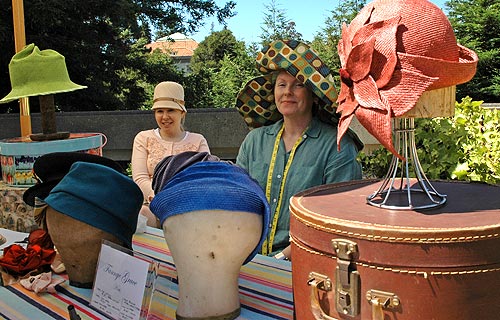 |
UC Berkeley staffer Carol Wood (right) and her friend Debora Ramirez started Fannye Grace Hats about a year and a half ago. (BAP photos) |
Berkeley staff craft alternate careers through hats, potions, and quilts
Got a tip? |
BERKELEY – This year's Staff Appreciation Day at UC Berkeley, called Summerfest, included a new feature in addition to the free ice cream, Wheel of Fortune giveaways, and benefits information tables set up on Memorial Glade.
Over on a terrace by Moffitt Library, some of the many creative individuals among Berkeley's 7,600 non-academic staffers displayed their personal crafts and hobbies, answering questions from those curious about jewelry making and photography, Matchbox car collecting and fishing flies.
Below, the NewsCenter talks to three Berkeley staff members about their passion for their crafts.
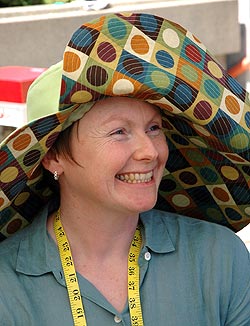 The Milliner
The Milliner
Carol Wood
Scholarship Program Coordinator,
Undergraduate Scholarships and Financial Aid
BACKGROUND "I attended College of Alameda's design program, where I learned garment design, including how to drape and fit. My friend Debora Ramirez and I began making fabric hats several years ago and last year we started doing women's felt and straw hats and some men's caps. I also have a side business in bridal dresses, and I'm designing the costumes for a Berkeley Masquers Playhouse stage production of 'Enchanted April.'"
DESIGN AESTHETIC "We're going for a retro feel."
MOTIVATION "Debora and I are both very active in the swing dance community, and we like to dress up. Vintage stuff is nice, but it just falls apart. So we decided to make our own hats."
SOURCE OF INSPIRATION "There's not just one. I've done Renaissance clothing before, but lately I've been interested in futuristic stuff, like the movie 'Gattaca.' The era that I swoon after is late 1920s and early '30s, when the cloches started receding and the garments became more slender."
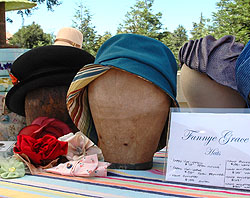 WHERE DID THE NAME "FANNYE GRACE HATS" COME FROM? "My
grandmother's name is Fannye, which I have always loved; Grace is Debora's
middle name. We just liked how old-fashioned it sounded."
WHERE DID THE NAME "FANNYE GRACE HATS" COME FROM? "My
grandmother's name is Fannye, which I have always loved; Grace is Debora's
middle name. We just liked how old-fashioned it sounded."
WHERE CAN WE BUY ONE? "I've made hats for others- both custom and as gifts - but our first real public showing was UC Berkeley's Summerfest. We're working on a website, and we're planning a novelty Christmas line of hats that we'll sell locally, such as to shops on Fourth Street. By next spring we hope you'll be able to find our hats in the specialty hat shops. And of course we're always open to custom orders."
HOW LONG DOES IT TAKE TO MAKE A HAT? "Anywhere from 30 minutes to a few weeks."
HOW MUCH DO THEY COST? $75 TO $300
HAS WORKED AT UC BERKELEY Four and a half years.
WOULD YOU TRADE YOUR JOB FOR YOUR CRAFT? "In a heartbeat!"
ARE YOU GOING TO GET IN TROUBLE FOR SAYING THAT? "No, everybody in my unit knows I'd like to be doing this full time. My heart is in design, and whether that's a garment, or home décor, or any of that - I'm also in the process of planning a wedding, an Art Deco wedding in a year in a half, planning the gown and the bridesmaids' gowns, and they're all going to have hats, of course."
AND THE GROOM? "Yes, he looks great in hats."
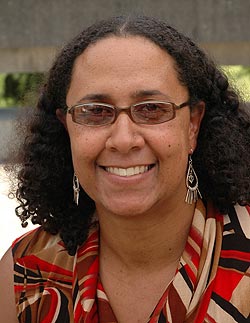 The Potion Maker
The Potion Maker
Monica Hastings-Smith
Senior Administrative Analyst,
Residential and Student Service Programs
BACKGROUND "A friend commanded me to buy some shea butter from a lady she knew, so I did, and I just loved it. I looked it up and learned that it is a nut butter that comes from the karite tree, which grows in a big swath across West and Central Africa. The nut butter itself is amazing, but it's also a protected crop, picked by a lot of women's collectives. Anyway, I started researching it about three years ago, and a year and a half ago my husband said, 'Enough research, let's do it!' And people have really liked our products and how we sell them."
WHICH IS HOW? "To regular customers from our home and at the Berkeley Flea Market on weekends. My husband, Michael, and I own and run the business, but it's really a family business. Our three kids help with the packaging and selling. They can explain all the products and their benefits. In fact, my 11-year old son is my top salesman."
WHY "BELOVED BODY"? "Well, our slogan is 'Love your Body,' and if you really love your body, you're going to treat it not just good, but great. And that means top-quality ingredients and no chemicals."
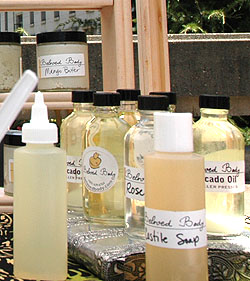 WHAT ARE YOUR MOST POPULAR PRODUCTS? "Shea butter - I have two kinds, one that's hand-pressed in Ghana and has the highest concentration of phytochemicals; the other is cold-pressed - but also our mango butter, tea tree oil, and Castile soap are big sellers.
WHAT ARE YOUR MOST POPULAR PRODUCTS? "Shea butter - I have two kinds, one that's hand-pressed in Ghana and has the highest concentration of phytochemicals; the other is cold-pressed - but also our mango butter, tea tree oil, and Castile soap are big sellers.
WHAT'S YOUR FAVORITE? "Right now it's hemp seed oil. All of my products are fantastic, but when you put this on your skin it's reactive, it's got this green grassy kind of smell and it's perfectly balanced oil."
WHAT'S DIFFERENT ABOUT BELOVED BODY CREAMS AND OILS? "Ours are 100 percent natural, with no synthetics and no colorants. We sell mostly unscented raw body products for people who don't like a lot of perfumes and weird chemicals. It's just the essential oil and the raw product, and I sell it for a lot less than they do at the Body Shop."
BUSINESS PHILOSOPHY "I have a lot of information about what I sell, what it does, the differences between shea butter and other nut butters. I know a lot about my products and I love to evangelize about them. They're good for everyone: grandmothers, babies, men, adolescent kids with pimples. I also believe you don't have to buy my stuff, but you should start thinking this way. Take your favorite shampoo and look at the ingredient list, and it will terrify you."
HAS WORKED AT BERKELEY "For six years. I'm also an alum ('87), and my mother, Iola James, retired from Berkeley's undergraduate engineering office. I'm a campus brat; the culture is very ingrained in me."
WOULD YOU RATHER DO BELOVED BODY FULL TIME? "I don't know. I love to evangelize about the products, but the business side is kind of a drag. I've seen what it takes to run a business full time, and I can't imagine doing that. Maybe if my family together decided this was what we wanted to do, I know we could make a good success. But I would miss doing what I do now - I enjoy the creative work I do, and my team."
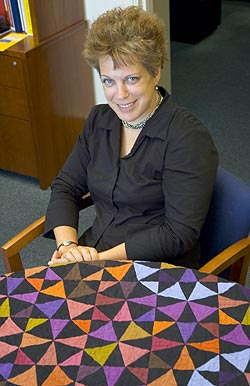 The Quilter
The Quilter
Jean Smith
Administrative Specialist,
Public Affairs
BACKGROUND "I made my first quilt about nine years ago. I learned it mostly from a book. I picked the easiest pattern I could and started sewing. Then I promptly realized I didn't know what the hell I was doing, so I went to New Pieces on Solano Ave. for help. Pretty soon I was going to quilt shows and joining a quilting guild."
HOW MANY QUILTS HAVE YOU MADE? "Probably 40 or 50."
HOW LONG DOES ONE QUILT TAKE? "About a month to do the piecing (cutting and sewing the small pieces), and then about two months to do the quilting - the stitching that holds the backing, middle, and top together."
DO YOU SKETCH IT OUT FIRST? "No, I'm too impatient. I usually pick a pattern and the colors I want to use, and then start sewing."
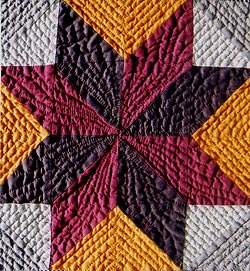 A detail of the intricate stitching. (Quilt photos courtesy of Jean Smith)  
|
EVERY EVENING? "Pretty much. At least from 8 to 10 p.m. Exciting life, huh?"
WHERE CAN I BUY ONE OF YOUR QUILTS? "I don't really sell them. I don't have the gumption to ask someone to pay what they're worth, so sometimes I give them away. I did sell one once in exchange for some art. Some I get really attached to. There's one that I worked on the whole time I was on vacation this summer in New Zealand. I'll never part with that one."
HOW MUCH ARE THEY WORTH? "A really intricate hand-quilted quilt is worth over $2,000."
WOW. WELL IF YOU'RE NOT SELLING THEM, ARE YOU SHOWING THEM? "I've just entered a quilt in the Pacific International Quilt Festival, to be held in mid-October. This is the first time I've entered one. It's a juried show, one of the biggest on the West Coast. They pick about 300 quilts to hang, and give out awards for 'Best Use of Color,' 'Best Traditional,' that sort of thing."
WHAT AWARD WOULD YOU LIKE TO WIN? "Win? I'd just like to get in the show! That would be so cool, to walk in and see my quilt hanging there."
YOU'VE WORKED IN PUBLIC AFFAIRS FOR 18 YEARS. WOULD YOU RATHER QUILT FULL TIME? If I could make a living at it, oh yeah."
IT'S NOT TOO SOLITARY FOR YOU? "Well, it's kind of hard to feel solitary with three dogs. And I go to quilting guild meetings, and my best friend, Kate, is also a quilter. That's how we spend New Year's Eve.
WHAT IS IT ABOUT QUILTING THAT YOU FIND SO ENGROSSING? "It's an outlet for my creative energies. I can draw, but I would never do that as a job, it doesn't appeal to me. Quilting is all instantaneous gratification, which I am way into. It's my therapy."

